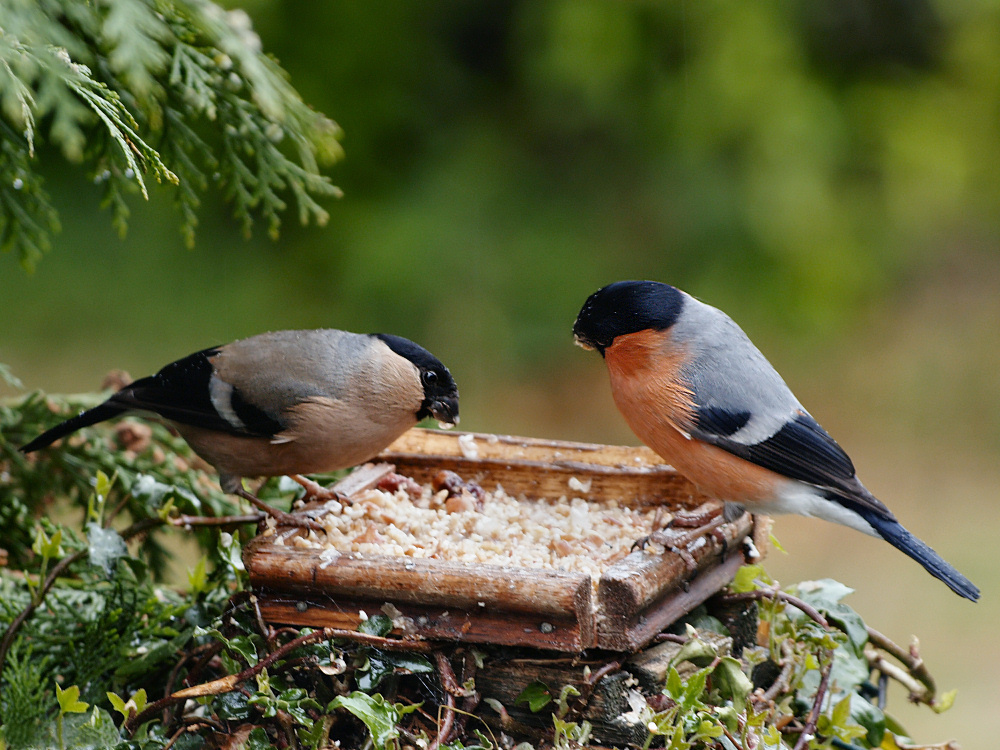|
Finch Family
The true finches are small to medium-sized passerine birds in the family Fringillidae. Finches have stout conical bills adapted for eating seeds and nuts and often have colourful plumage. They occupy a great range of habitats where they are usually resident and do not migrate. They have a worldwide distribution except for Australia and the polar regions. The family Fringillidae contains more than two hundred species divided into fifty genera. It includes species known as siskins, canaries, redpolls, serins, grosbeaks and euphonias. Many birds in other families are also commonly called "finches". These groups include the estrildid finches ( Estrildidae) of the Old World tropics and Australia; some members of the Old World bunting family ( Emberizidae) and the New World sparrow family ( Passerellidae); and the Darwin's finches of the Galapagos islands, now considered members of the tanager family ( Thraupidae).Newton (1973), Clement ''et al.'' (1993) Finches and canaries ... [...More Info...] [...Related Items...] OR: [Wikipedia] [Google] [Baidu] |
Eurasian Bullfinch
The Eurasian bullfinch, common bullfinch or bullfinch (''Pyrrhula pyrrhula'') is a small passerine bird in the finch family, Fringillidae. In Anglophone Europe it is known simply as the bullfinch, as it is the original bird to bear the name bullfinch. Taxonomy and systematics The Eurasian bullfinch was formally described in 1758 by Linnaeus in the 10th edition of his ''Systema Naturae'' under the binomial name ''Loxia pyrrhula''. It is now placed in the genus '' Pyrrhula'' that was introduced in 1760 by the French zoologist Mathurin Jacques Brisson. The Latin word ''pyrrhula'' comes from the Greek ''πυρρός'' (a flame-coloured bird, from πυρρός flame coloured, from ''πυρ'' fire : Pyrrha), a 'worm eating bird' that is mentioned by Aristotle. The Latin name ''pyrrhula'' for the Eurasian bullfinch had been used in 1555 by the Swiss naturalist Conrad Gesner in his '' Historiae animalium''. Subspecies Ten subspecies are recognised: * ''P. p. pileata'' MacGillivray, ... [...More Info...] [...Related Items...] OR: [Wikipedia] [Google] [Baidu] |
Bunting (bird)
The buntings are a group of Old World passerine birds forming the genus ''Emberiza'', the only genus in the family Emberizidae. The family contains 45 species. They are seed-eating birds with stubby, conical bills. Taxonomy The family Emberizidae was formerly much larger and included the species now placed in the Passerellidae (New World sparrows) and Calcariidae (longspurs and snow buntings). Molecular phylogenetic studies found that the large family consisted of distinct clades that were better treated as separate families. The genus ''Emberiza'' is now the only genus placed in the family Emberizidae. The genus was introduced by the Swedish naturalist Carl Linnaeus in 1758 in the tenth edition of his ''Systema Naturae''. The type species was subsequently designated as the yellowhammer (''Emberiza citrinella''). The genus name ''Emberiza'' is from Old German ''Embritz'', a bunting. The origin of the English "bunting" is unknown. A 2008 genetic study found that three emberizid ... [...More Info...] [...Related Items...] OR: [Wikipedia] [Google] [Baidu] |
Mitochondrion
A mitochondrion (; ) is an organelle found in the cells of most Eukaryotes, such as animals, plants and fungi. Mitochondria have a double membrane structure and use aerobic respiration to generate adenosine triphosphate (ATP), which is used throughout the cell as a source of chemical energy. They were discovered by Albert von Kölliker in 1857 in the voluntary muscles of insects. The term ''mitochondrion'' was coined by Carl Benda in 1898. The mitochondrion is popularly nicknamed the "powerhouse of the cell", a phrase coined by Philip Siekevitz in a 1957 article of the same name. Some cells in some multicellular organisms lack mitochondria (for example, mature mammalian red blood cells). A large number of unicellular organisms, such as microsporidia, parabasalids and diplomonads, have reduced or transformed their mitochondria into other structures. One eukaryote, '' Monocercomonoides'', is known to have completely lost its mitochondria, and one multicellular organ ... [...More Info...] [...Related Items...] OR: [Wikipedia] [Google] [Baidu] |
Raymond Andrew Paynter, Jr
Raymond is a male given name. It was borrowed into English from French (older French spellings were Reimund and Raimund, whereas the modern English and French spellings are identical). It originated as the Germanic ᚱᚨᚷᛁᚾᛗᚢᚾᛞ (''Raginmund'') or ᚱᛖᚷᛁᚾᛗᚢᚾᛞ (''Reginmund''). ''Ragin'' (Gothic) and ''regin'' (Old German) meant "counsel". The Old High German ''mund'' originally meant "hand", but came to mean "protection". This etymology suggests that the name originated in the Early Middle Ages, possibly from Latin. Alternatively, the name can also be derived from Germanic Hraidmund, the first element being ''Hraid'', possibly meaning "fame" (compare ''Hrod'', found in names such as Robert, Roderick, Rudolph, Roland, Rodney and Roger) and ''mund'' meaning "protector". Despite the German and French origins of the English name, some of its early uses in English documents appear in Latinized form. As a surname, its first recorded appearance in Bri ... [...More Info...] [...Related Items...] OR: [Wikipedia] [Google] [Baidu] |
Convergent Evolution
Convergent evolution is the independent evolution of similar features in species of different periods or epochs in time. Convergent evolution creates analogous structures that have similar form or function but were not present in the last common ancestor of those groups. The cladistic term for the same phenomenon is homoplasy. The recurrent evolution of flight is a classic example, as flying insects, birds, pterosaurs, and bats have independently evolved the useful capacity of flight. Functionally similar features that have arisen through convergent evolution are ''analogous'', whereas ''homologous'' structures or traits have a common origin but can have dissimilar functions. Bird, bat, and pterosaur wings are analogous structures, but their forelimbs are homologous, sharing an ancestral state despite serving different functions. The opposite of convergence is divergent evolution, where related species evolve different traits. Convergent evolution is similar to paralle ... [...More Info...] [...Related Items...] OR: [Wikipedia] [Google] [Baidu] |
|


.jpg)

